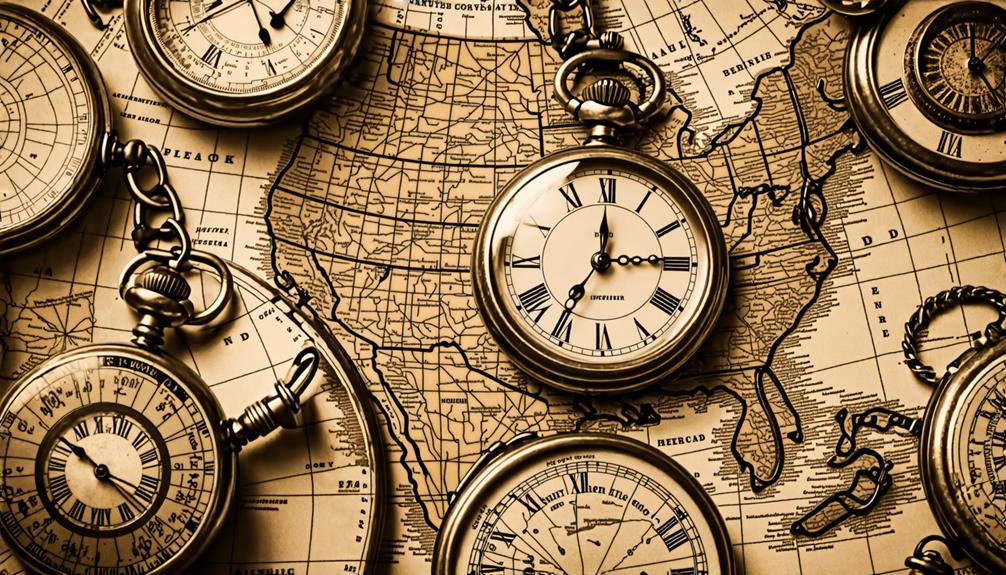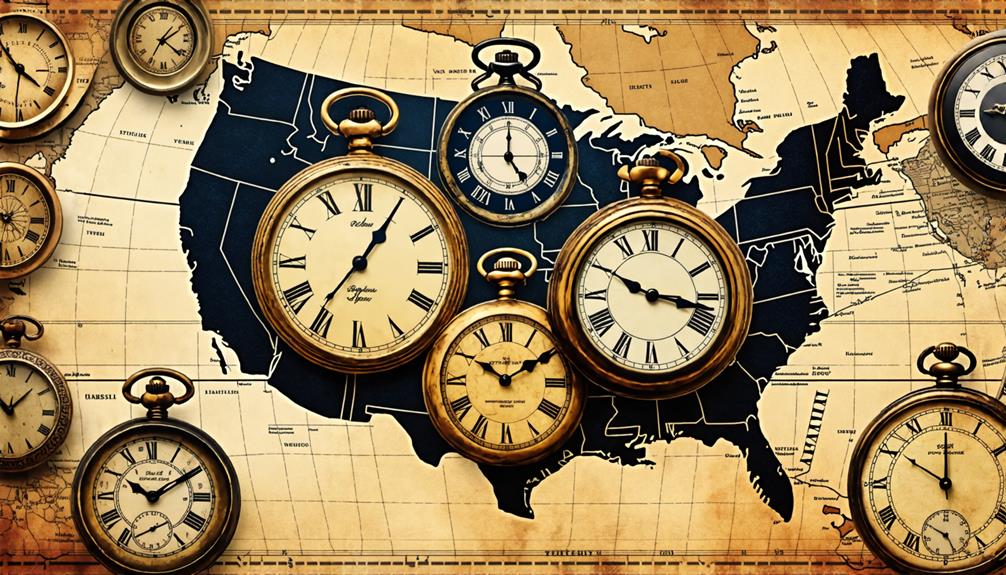You might think that knowing the time is a simple matter, but imagine a world where crossing town could mean adjusting your watch. Before 1883, North America was a patchwork of over 144 local times, creating a logistical nightmare for travelers and businesses alike. As you'd step off a train, you'd find yourself in a temporal guessing game, never quite sure if you were early, late, or right on time. This chaotic timekeeping system posed significant challenges, particularly as the railroad industry boomed. But what prompted this temporal tangle, and how did it impact daily life in 19th-century America?
Key Takeaways
- North America had over 144 local times before standardized time zones in 1883.
- Local times were based on solar noon, causing significant variations between nearby locations.
- Lack of uniform time created confusion and scheduling problems, especially for railroads.
- Time discrepancies increased accident risks and inefficiencies in transportation and communication.
Chaos of Local Times

Before 1883, you'd find yourself maneuvering a chaotic landscape of over 144 local times across North America, causing widespread confusion and scheduling nightmares.
As you traveled from town to town, you'd encounter varying times, sometimes differing by minutes or hours. This chaos wreaked havoc on transportation, especially with the expanding railroad system.
You'd face significant scheduling difficulties, struggling to coordinate connections and grappling with the inefficiencies of multiple local times. The faster trains became, the more dangerous this system proved, increasing the risk of accidents and missed connections.
The lack of standardized time zones made it nearly impossible to maintain efficiency and safety in transportation across the continent. This state of affairs ultimately necessitated the creation of a coordinated time system to bring order to the chaos and improve travel experiences for everyone.
Rise of Railroad Travel
As the chaos of local times reached its peak, the rapid expansion of railroad travel in the 19th century brought the issue to a boiling point, demanding a solution to the timekeeping nightmare.
You'd encounter significant challenges when traveling by train, as local time varied widely between neighboring towns. This led to:
- Missed connections
- Scheduling difficulties
- Confusion among passengers and staff
The prevalence of these problems underscored the urgent need for a unified time system.
In 1883, major railroad companies took matters into their own hands, introducing four standardized time zones. This move revolutionized transportation, improving safety and efficiency in railroad operations.
The establishment of time zones not only streamlined scheduling but also enhanced communication and trade across the growing network of railroads in North America.
The era of standardized time had begun, paving the way for modern timekeeping practices.
Standardization of Time Zones

The standardization of time zones in 1883 marked a pivotal moment in North American timekeeping, ushering in an era of improved coordination and efficiency across the continent.
You'll find that major railroad companies spearheaded this change, creating four standardized time zones: Eastern, Central, Mountain, and Pacific. This move considerably enhanced scheduling and safety in travel, addressing the challenges posed by the previous system of over 144 local times.
The new time zones eliminated discrepancies that had complicated railroad operations and passenger travel. By 1918, the U.S. government officially adopted five time zones, adding Alaska to the mix.
This standardization laid the groundwork for future improvements in timekeeping, culminating in the Uniform Time Act of 1966. This act further regulated timekeeping practices and introduced Daylight Saving Time nationwide, cementing the importance of uniformity in timekeeping across North America.
Conclusion
You've seen how the multitude of local times created chaos across North America before 1883.
As you've learned, the rise of railroad travel exposed the pressing need for standardization.
Now you understand why the establishment of time zones was a vital step forward.
It's hard to imagine the confusion you'd face today without this system.
Next time you check your watch, you'll appreciate the order that time zones brought to our daily lives.

Leave a Reply